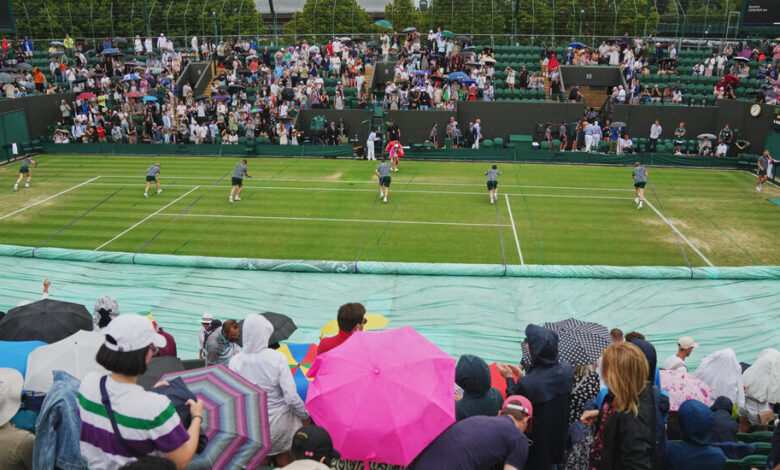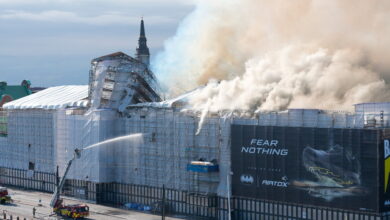How Do Wimbledon’s Grass Courts Preserve Dry In All The Rain?

[ad_1]
Excessive atop the outer south wall of Centre Court docket at Wimbledon, a small rectangle has been minimize away within the lush, inexperienced ivy, revealing a digital quantity that few, if any, of the 42,000 spectators coming into the grounds every day of the match ever discover.
Just like coastal warning pennants, it’s a sign system — from 1 to eight — issued from Wimbledon’s personal crack meteorology division, for the tarpaulin crews to standby or rush into motion. A “1” means doable showers. A “2” means the chair umpire has the discretion to halt the match. On Saturday, when the primary rain drops fell on an already rain-soaked Wimbledon, the sign clicked to “4” from “3.”
Immediately, Richard “Winston” Sedgwick, standing on the final row of Court docket No. 3, the place he may see throughout to the digital beacon on Centre Court docket, used a easy hand sign to relay the knowledge to the crews, which rushed to motion. A six-member staff ran onto the courtroom, grabbed purple cords to unwrap a 8,000-square-foot tarpaulin and hauled it over the courtroom in about one minute, with the captains shouting out directions heard all concerning the grounds, much like rowing groups: “Three, two, one, pull,” and “Keep collectively. Once more!”
“There’s stress to get it achieved correctly,” Sedgwick mentioned. “In case you don’t, they will’t play. So, we’ve to work actually arduous and actually quick.”
The members of the protecting crews are arguably crucial individuals at Wimbledon, their swift, exact motion defending the fragile grass, permitting tennis to proceed on every of the 18 courts at what’s often the rainiest Grand Slam of the 12 months.
It’s a bodily job, requiring a sure diploma of athleticism, and if there’s a day with intermittent showers and the tarp goes on and off a number of instances, by the tip of that day, the bodily toll renders the crews “shattered,” Sedgwick mentioned.
George Spring, a cattle farmer in New South Wales, Australia, has been Wimbledon’s courtroom providers supervisor for 22 years, overseeing your complete course of. It begins when his spouse, Louise, recruits the a number of dozen college college students who kind the crews. In all, 200 individuals work on the courtroom providers crews over the two-week match.
They prepare for 4 days earlier than the match, together with a pair of half days on courtroom, the place they study and follow the best way to pull the tarps on, take them off, and arrange the nets and the remainder of the courtroom for play as soon as the rain stops.
Actions should be in live performance, and the crews rehearse their ballet nicely earlier than the primary ball is struck.
“It’s like sporting groups,” Spring mentioned. “In case you’ve bought an excellent captain and good management, you’ll be in fine condition.”
The crews have been particularly necessary at this Wimbledon, the place rain has interrupted 5 of the primary six days. It has created havoc with the schedule and compelled many gamers to work on back-to-back days, which is rarely the plan at a two-week occasion like Wimbledon. By way of the primary six days, 96 matches have been suspended, together with 34 on Wednesday and 30 on Saturday. A number of doubles groups had not even performed their first matches by Saturday.
And this isn’t even the rainiest Wimbledon — not even shut.
“I used to be right here in 2007, the place it was well-known for rain,” Spring mentioned. “There wasn’t a day we didn’t pull a canopy on the courts.”
The 2 most important present courts, Centre Court docket and Court docket No. 1, have retractable roofs, however the crews nonetheless deploy even bigger tarps, requiring 20 individuals vs. the six on the outer courts, whereas the roofs are closing. Centre Court docket is the one one with full-time Wimbledon workers on the job.
The courtroom providers crews arrive at 7:30 a.m. and work till about 10:30 p.m. every day. Tarps might be slippery and heavy and persons are transferring quick, so sometimes a crew member sprains an ankle or tweaks a muscle.
On Court docket No. 1, Elinor Beazley, who grew up in Wales and performed tennis for Northern Arizona College (she is transferring to Youngstown State this fall), has been pulling the tarp for 2 years.
Final 12 months was a principally sunny affair, and she or he discovered herself hoping for rain simply to get into the motion. When it arrived, the adrenaline started to pump.
“I used to be so nervous,” she mentioned. “The group was screaming and I used to be getting actually bubbly on my toes. It’s so thrilling and such a enjoyable expertise. It’s a little bit of a efficiency doing it in entrance of all these individuals.”
When she bought again to Arizona, she mentioned, she instructed her teammates, “All of you must come to Wimbledon. You watch the very best tennis on this planet up shut, and it’s like being on a staff.”
The courtroom providers crews are additionally chargeable for different duties, like holding umbrellas over the heads of the gamers throughout changeovers and offering them with towels and drinks, however they will fulfill different distinctive requests, too. Spring mentioned {that a} participant as soon as requested for a tender drink, which isn’t a part of the same old sports-hydration liquids obtainable on every courtroom. Spring went to the concession stand, purchased a soda and introduced it again.
One 12 months, when the bananas saved readily available for gamers have been too inexperienced, Spring mentioned, he despatched a crew member to a grocery retailer in Wimbledon city on a bicycle to obtain ripe ones. Rafael Nadal, who didn’t play this 12 months, likes a selected form of dried date, which Spring will get from the commissary on the grounds. On Saturday evening, there was a request for room-temperature water.
However crucial job is getting these tarps on and off the courts rapidly and utterly. When the digital beacons (there are just a few, posted on each side of Centre Court docket and on the outer partitions of Court docket No. 1) flashes a “5,” it’s the name to inflate the tarp. After a crew has secured the tarp with giant clips, blowers inflate it from the corners. Inside seconds a dome, 6 ft excessive within the middle, is fashioned, like an enormous bouncy citadel. If the rain is anticipated to move rapidly, the tarp shouldn’t be inflated in any respect.
A “6” means deflate; “7” is the decision to uncover and roll up the tarp, which may weigh two tons when it’s moist, Spring mentioned. When it’s secured, an “8” will flash, which suggests it’s time to gown the courts — change the nets, arrange the chairs and distribute the towels and drinks for the gamers.
Coloured cords wrapped contained in the rolled-up tarp make all of it a lot easier. The crew members pull purple ones to unfurl the tarp within the rain and inexperienced ones to roll it again up when the skies clear. The complete uncovering course of, together with establishing the nets, takes roughly 10 to fifteen minutes.
At evening, the crews put the tarps again on once more. On Saturday, play was suspended on all the outer courts due to the rain. When it stopped, the crews pulled the the tarps off once more, however just for lower than an hour. The tarp pullers have been so environment friendly in conserving the courtroom dry that the grass needed to be watered on the finish of the day.
Spring mentioned that in all his years, there have been just a few instances the place malfunctions brought on delays of an hour or so, however by no means for an entire day.
“That’s most likely why I’m nonetheless right here,” he mentioned.
And at Wimbledon, so is the rain.
[ad_2]
Source link



